Storing birdseed properly is essential for any backyard bird enthusiast. Whether you’re filling feeders year-round or ramping up during winter, keeping your birdseed clean, dry, and secure ensures it stays fresh and attracts more feathered visitors. Poor storage can lead to mold, pests, or spoilage, wasting money and effort. In this guide, we’ll cover the best methods for storing birdseed, from bulk buying to daily use, based on real-world experience with multiple feeders.
If you’re dealing with high-turnover seeds like nyjer for goldfinches, freshness is key—stale seed gets ignored. Proper storing birdseed practices also protect against wildlife raids and weather damage. For bird lovers expanding their knowledge, check out details on sun conure eye infection to understand how seed quality impacts bird health overall.
Buying Birdseed in Bulk
Purchasing birdseed in large quantities saves money, especially for heavy users. I stock up on sunflower hearts, safflower, and nyjer in 50-pound bags, peanuts in the shell in 25-pound bags, and white proso millet in 20-pound bags during winter. Local stores like my nearby bird shop (now a Wild Birds Unlimited) offer the freshest options at the best prices.
Fresh birdseed stored correctly lasts months. Nyjer dries out faster, so I buy big bags only because I go through 50 pounds monthly—goldfinches demand quality. Smaller quantities suit lighter feeders to avoid waste. For buying tips, see resources like the Audubon Society’s guidelines on seed selection.
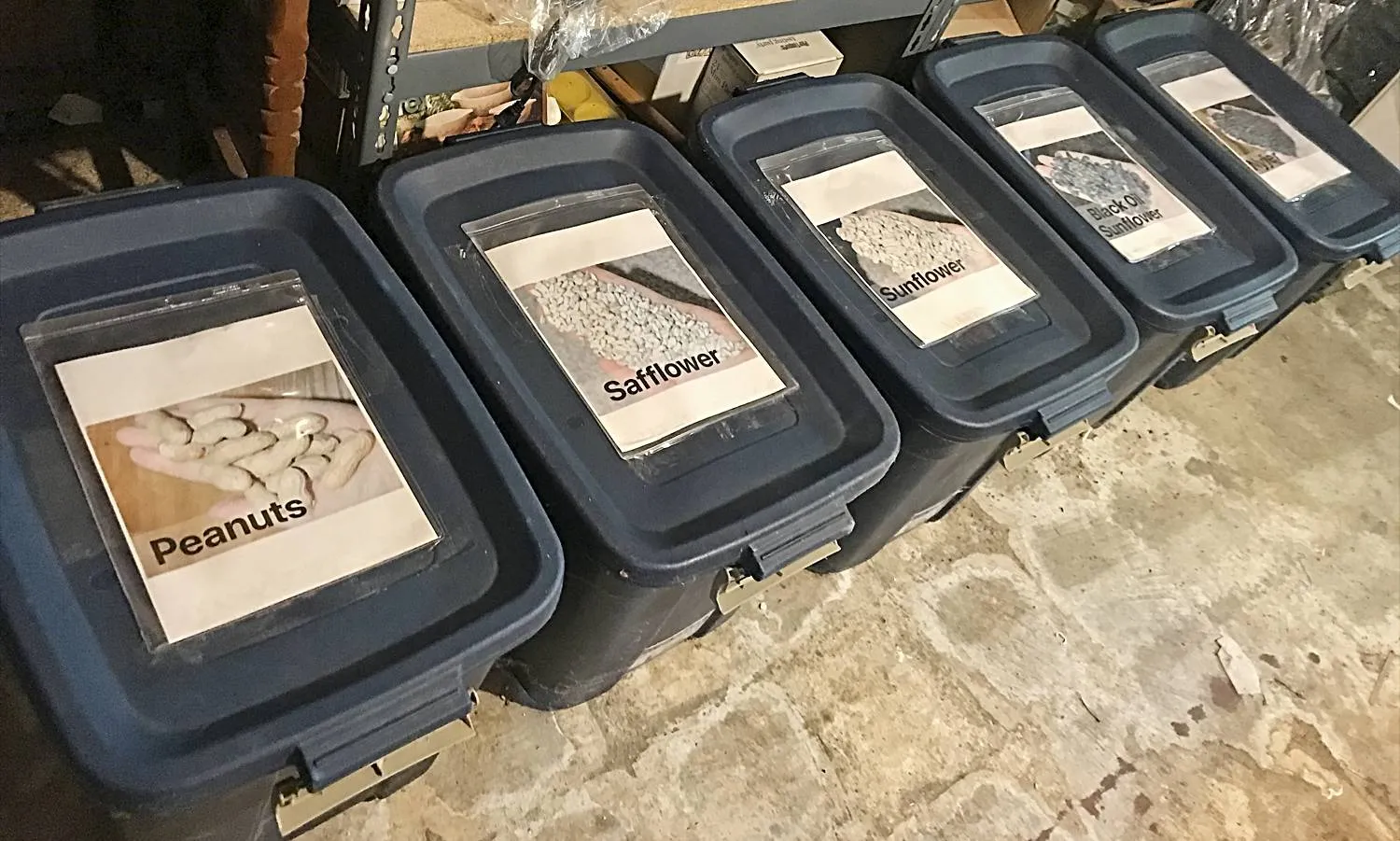 Birdseed Stored in Plastic Bins
Birdseed Stored in Plastic Bins
Indoor storage beats outdoor every time, but a sealed garage works as backup.
Storing Birdseed Indoors: Pros and Cons
Keeping birdseed inside the house offers unmatched convenience and protection. It’s my go-to method, with quick access even on stormy days—no digging through snow or risking wet seed.
Key Pros:
- Easy reach without exposure to heat, moisture, or critters.
- No rot from rain or snow, keeping you dry too.
- Reduced pest access, like raccoons or squirrels.
Potential Cons:
- Space limits mean some goes to the basement (great for exercise!).
- Occasional moths from bags—tight lids help.
- Mice risk if they sneak in; I solved this with humane traps baited with peanut butter and sealed entry points.
Experience shows indoor storing birdseed minimizes headaches. A reliable trap like the Smart Mouse Trap proved effective in my home.
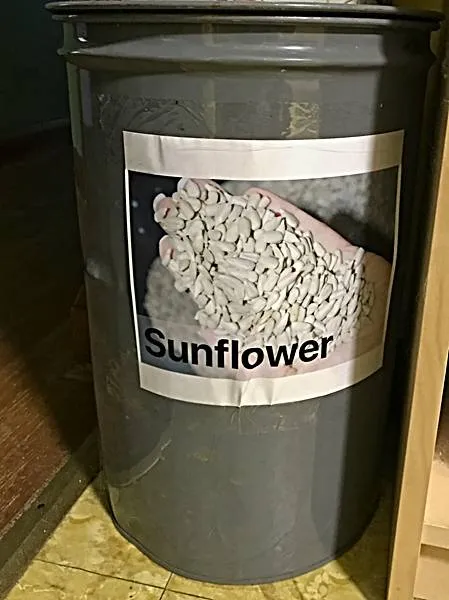 Sunflower Stored in an Old Metal Container
Sunflower Stored in an Old Metal Container
Choosing the Right Containers: Metal vs. Plastic
Opt for sturdy metal or heavy-duty plastic bins over original bags. Bags spill easily and invite pests, even indoors. Metal resists chewing better—galvanized for outdoors to prevent rust. Plastic works inside if thick enough, available at home stores like Lowe’s or Home Depot.
Both types seal tightly, preserving freshness. I’ve used them interchangeably with success.
Three Effective Ways to Store Birdseed
1. Metal Tins for Smaller Amounts
In my kitchen, large lidded metal tins hold a week’s supply each. Repurposed from holiday popcorn tins, candy gifts, or desiccant containers, they sit on shelves or floors. One even stores mealworms.
Local bird stores sell small galvanized pails too. Ideal if you buy under 20 pounds.
 Mealworms and Millet Stored in Old Christmas Treat Tins
Mealworms and Millet Stored in Old Christmas Treat Tins
These tins handle daily needs perfectly, freeing larger spaces for bulk.
2. Large Plastic Bins for Bulk Storage
Previously, 18-gallon “Rugged Tote” plastic bins lined my basement, fitting 50+ pounds per bin. Scooping was simple—align them for efficiency.
But mice chewed through one, turning storage into a rodent party. Cats loved it; I didn’t.
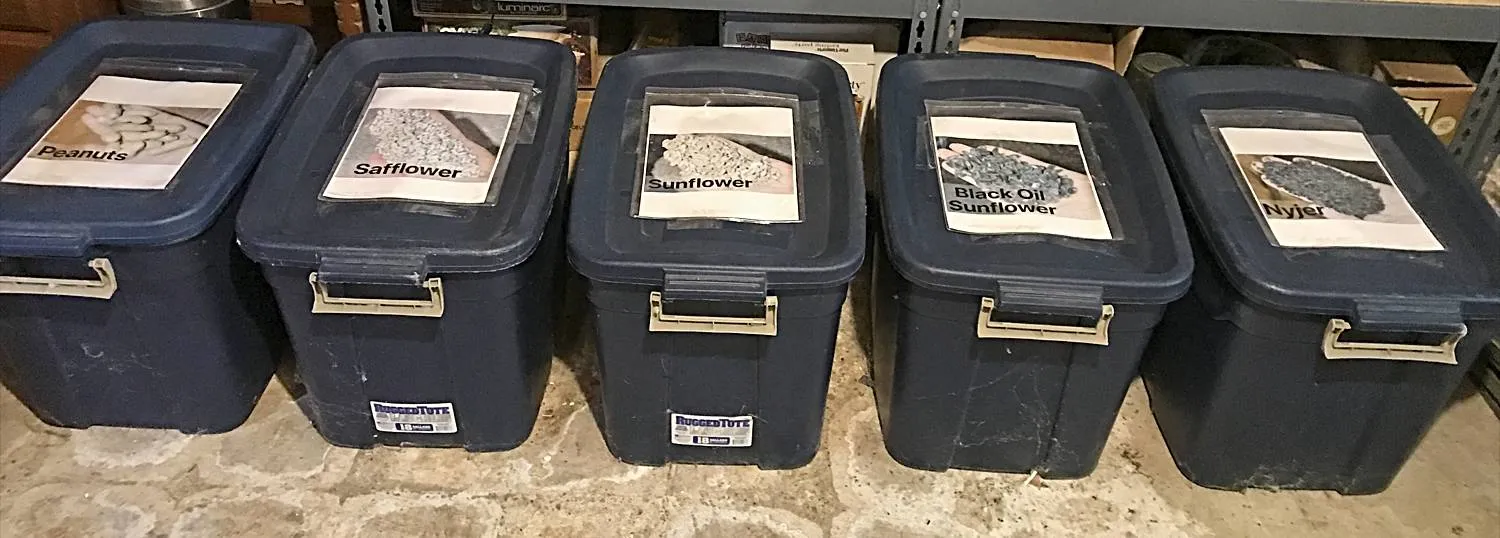 Birdseed Stored in Large Plastic Storage Containers
Birdseed Stored in Large Plastic Storage Containers
Switching solved the issue long-term.
3. Galvanized Metal Cans for Ultimate Protection
Now, I use 20-gallon and 31-gallon galvanized cans. The medium one holds peanuts; larger ones take two 50-pound bags of sunflower hearts, safflower, or nyjer. Bought from bird stores and Home Depot, they’re chew-proof and spacious for sales or winter stockpiles.
Blue jays flock to peanuts—explore more on blue jay behaviour for feeder insights.
 Birdseed and Peanuts Stored in Galvanized Metal Cans
Birdseed and Peanuts Stored in Galvanized Metal Cans
This setup handles my heaviest use without compromise.
Labeling Your Birdseed Containers
Labels prevent mishaps, especially with helpers. I print seed photos with names.
Kitchen tins get side labels under clear packing tape—visible on shelves. Downloadable versions are available online for easy printing.
 Labeled Birdseed Tin
Labeled Birdseed Tin
Basement bins use lid-mounted vinyl holders for changeable, clean labels—scoop jars don’t damage them.
 Labeled Birdseed Storage Bins
Labeled Birdseed Storage Bins
Galvanized cans will follow suit on sides if needed.
Practical Scoops for Easy Handling
Repurposed 30-ounce trail mix jars scoop perfectly—one fills a feeder. Carry multiples outside spill-free. For nyjer tubes, pour into a spouted pitcher first.
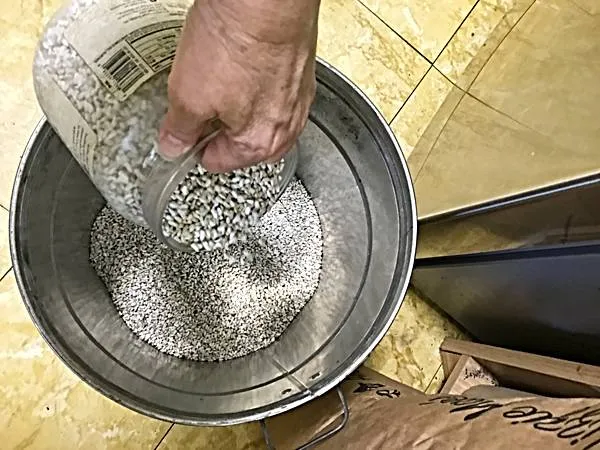 Re-using a Trail Mix Jar as a Seed Scoop
Re-using a Trail Mix Jar as a Seed Scoop
These make transfers smooth.
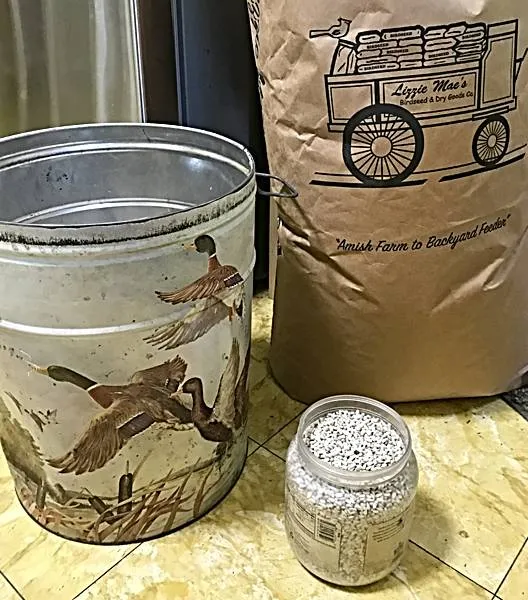 Storage Tin and Safflower Seed
Storage Tin and Safflower Seed
Bringing Birdseed Home and Organizing
Drop 50-pound bags near the kitchen door (use help or a dolly if heavy). Scoop into tins and feeders first, then haul remnants downstairs. Recycle bags immediately.
 Sunflower Seed in a Storage Bin
Sunflower Seed in a Storage Bin
Daily Feeder Filling Routine
Daily checks via windows or yard walks gauge needs. Fill jars from kitchen first, basement second. The 10-minute process includes birdbaths—efficient and enjoyable.
Why Proper Storing Birdseed Matters
Good storage extends seed life, blocks pests, and simplifies feeding. Invest time upfront for daily ease, then enjoy the birds. My system evolved from plastic mishaps to metal reliability—what’s yours?
Follow vet-recommended practices and consult local experts for your climate.
References
- Audubon Society: Birdseed Selection and Storage Guidelines
- Wild Birds Unlimited: Bulk Seed Handling Tips
- Original insights from Nancie, updated May 2024
Read more on bird care—subscribe for updates!
